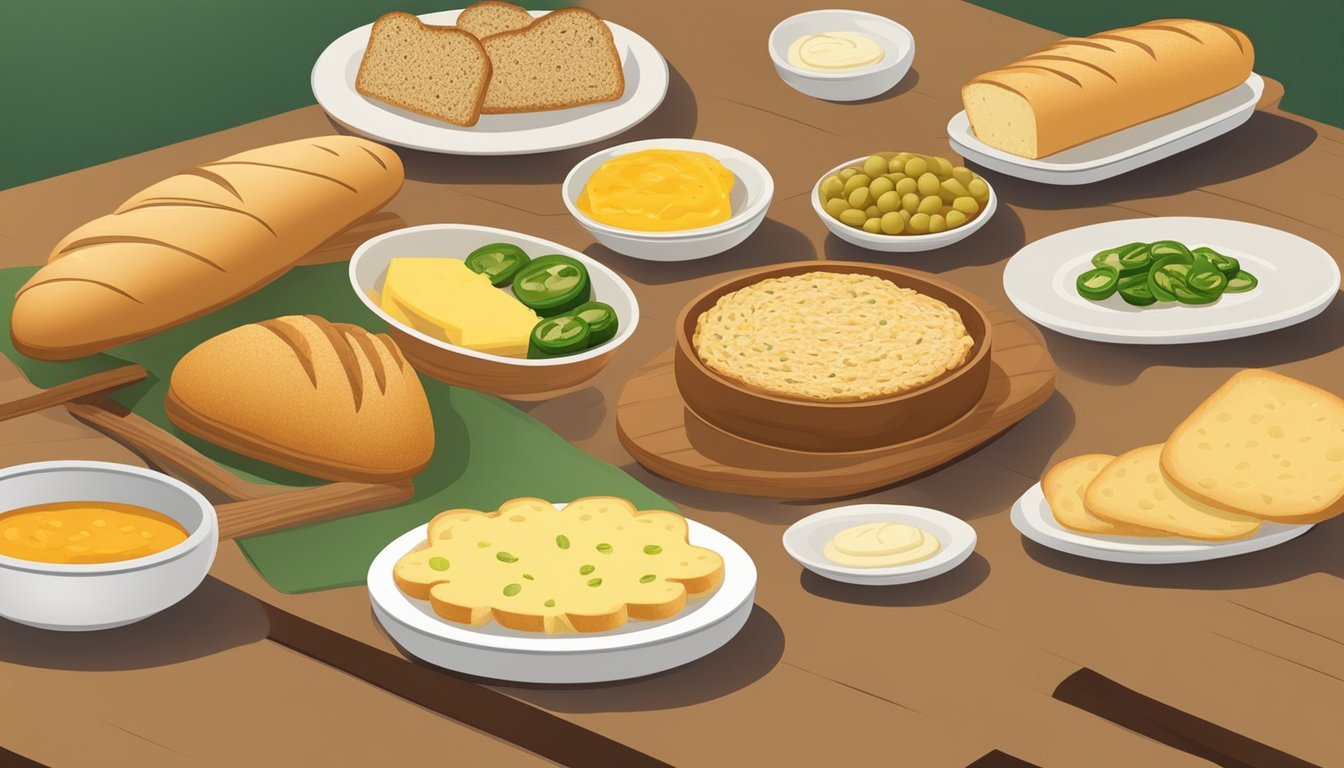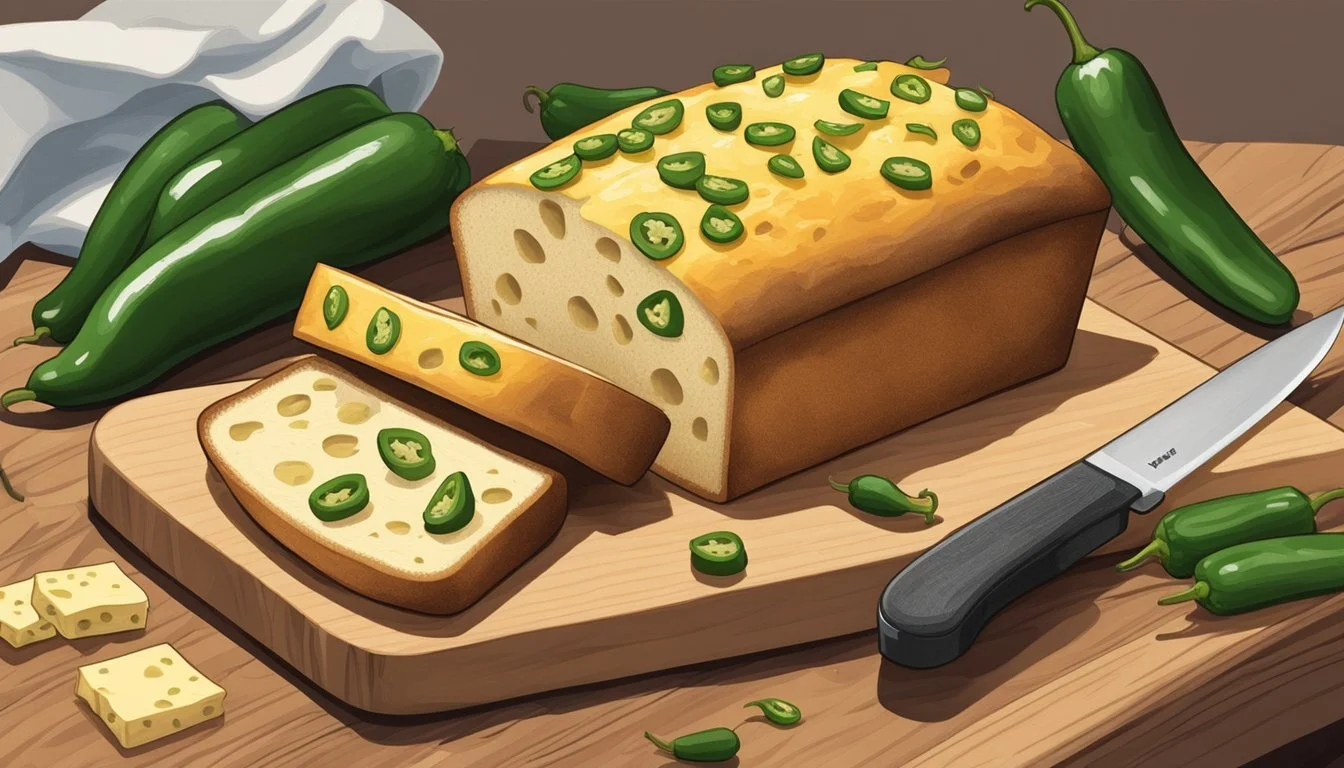Jalapeño Cheese Bread Substitutes
Top Alternatives for Spicy Bread Lovers
Jalapeño cheese bread offers a gastronomic harmony of spice and sharp, cheddar tang, presenting a unique flavor for palates craving zest in their bread selection. However, dietary restrictions, ingredient availability, or a simple desire for variety might nudge one towards substitutes that still capture the essence of this spicy, cheesy delight. Many bakers and home cooks seek to replicate or replace the signature elements of jalapeño cheese bread with alternatives that cater to a range of dietary preferences and culinary constraints.
Substitutes for jalapeño in the bread can range from milder chili peppers to bell peppers for those with lower heat tolerance, while introducing different types of cheese, such as mozzarella or gouda, offers new dimensions of flavor and texture. The essential character of jalapeño cheese bread also permits creative adaptations in the bread base itself. Traditional wheat flour can be swapped for gluten-free options, or one might forgo kneading entirely with no-knead bread variations that preserve the crusty exterior and soft interior that fans love.
When considering no knead jalapeño cheese bread, one finds the process not only more approachable for amateur bakers but also ripe for variation. Bakers can experiment with the incorporation of whole grains, seeds, or alternate flours to cater to health-conscious consumers or those with specific nutritional goals. The simplicity of these methods encourages even the most novice bakers to produce a loaf that does justice to the rich, bold flavors this culinary fusion is known for.
Overview of Bread Substitutes
In the realm of baking, bread substitutes often serve to accommodate dietary restrictions and health preferences. They range from alternative flours to non-traditional ingredients that redefine the concept of bread as we know it.
Understanding Bread Alternatives
Bread alternatives come in a variety of forms and recipes, each substituting conventional bread ingredients like all-purpose or bread flour with more unique options. Alternatives to traditional wheat flour include:
Cauliflower Flour: Used in recipes like cauliflower tortillas and flatbreads.
Almond Flour: A gluten-free option high in protein.
Coconut Flour: A low-carb flour that's rich in fiber.
These substitutes offer different textures, flavors, and nutritional profiles, often resulting in a product that's palatable for those seeking a healthier lifestyle or with specific dietary needs.
Health and Dietary Considerations
When selecting bread substitutes, one must consider their health impact and compatibility with dietary restrictions. Key considerations include:
Gluten-Free Needs: For those with celiac disease or gluten sensitivities, flours derived from nuts or vegetables are ideal.
Carbohydrate Intake: Low-carb flours like almond or coconut can aid those following a ketogenic diet.
Fiber Content: Substitutes like cauliflower provide a higher fiber content, which can be beneficial for digestive health.
The ingredient list of such substitutes often steers clear of additives found in traditional bread, thus appealing to health-conscious consumers.
Jalapeño Cheese Bread Ingredients
In crafting Jalapeño Cheese Bread, the choice of ingredients dictates both the flavor and texture of the final loaf. Selecting quality flour, cheese, and jalapeños, along with proper leavening agents, ensures a balance between spicy, cheesy goodness and bread that rises beautifully.
Types of Flour and Their Substitutes
The base of any bread is the flour, and all-purpose flour is commonly used due to its moderate gluten content, which is crucial for the dough's elasticity.
Substitutes:
Bread flour: higher in gluten, it makes a chewier bread
Whole wheat flour: adds a nutty flavor and denser texture
Gluten-free blends: for those with gluten intolerance
Cheese Varieties and Alternatives
Cheddar cheese is a classic choice for this bread, offering a rich, tangy taste.
Alternatives:
Sharp cheddar cheese: provides a more intense flavor
Monterey Jack: mellower in taste
Pepper Jack: adds additional heat
Colby: similar to cheddar but softer and milder
Vegan cheeses: for a dairy-free version, although they might not melt as well
Selecting the Right Jalapeños
Jalapeños are the star of this bread, contributing the characteristically spicy kick.
For a less spicy variation, one can use pickled jalapeños, which are milder due to the pickling process.
Alternatively, leaving the seeds in the jalapeños will increase the heat for those who prefer a spicier bread.
Additional Flavoring Components
Apart from flour, cheese, and jalapeños, other ingredients play a supporting role in enhancing the flavor and texture of the bread.
Yeast: Active dry yeast or instant yeast can be used to help the dough rise.
Sugar or honey: A small amount can be added to feed the yeast, aiding in the rise.
Salt: Enhances overall flavor; sea salt or kosher salt can be used for distinct tastes.
Garlic: Fresh or powdered garlic can be included for an additional layer of flavor.
By considering each component and its alternatives, one can create a Jalapeño Cheese Bread that both meets dietary preferences and satisfies taste buds.
Preparing the Dough
The process of preparing dough for Jalapeño Cheese Bread involves specific techniques to ensure successful mixing, consistency, and rise before it is shaped and ready for baking.
Mixing Techniques
One begins the process by combining dry ingredients, typically including flour, yeast, and salt. At this stage, stand mixers equipped with dough hooks are advantageous, as they evenly distribute the ingredients. Cheddar cheese and chopped jalapeños are folded into the mixture, often by hand to prevent overworking them. A mixer can be used on a low speed to incorporate the cheese and jalapeños if preferred.
Achieving the Proper Consistency
The hydration of the dough is critical; water must be added slowly and mixed until the dough forms a tacky, but not overly sticky, texture. Using a thermometer to ensure the water is at the right temperature (between 105°F to 110°F) optimizes yeast activity. Dough that's too dry won't rise properly, while overly wet dough can result in dense bread.
Kneading and Rising
When kneading the dough, thoroughness is key, whether one is employing a stand mixer or doing it by hand. Kneading develops the gluten strands that give the bread its structure. Following kneading, the dough must rise until it doubles in size, which may require a longer rising time in cooler climates. A warm environment supports the rise; however, too high a temperature can kill the yeast and halt the rising process.
Dough Shaping Methods
After rising, the dough is shaped according to preference, whether into a ball or a loaf, on a floured surface to prevent sticking. Shaping the dough should be done gently to maintain air pockets established during the rise. Prior to baking, one might shape the dough with slashes using a sharp knife, which allows for expansion and creates a visually appealing crust.
Baking Process
Crafting the perfect Jalapeño Cheese Bread involves a precise baking process that ensures a scrumptious balance of flavors and textures. Mastery of oven preparation, baking methods, the achievement of an ideal crust, and appropriate cooling and storage is paramount.
Oven Preparation
Before commencing the bread-making routine, one must preheat the oven to the right temperature to bake the bread evenly. Most recipes recommend heating the oven to 450°F (230°C). A Dutch oven should be placed inside while it preheats to create the ideal baking environment. The use of parchment paper can prevent sticking and provide easy removal of the bread post-baking.
Baking Methods and Techniques
Jalapeño Cheese Bread typically follows a no knead bread recipe, simplifying the process significantly. The bread is shaped into a ball, scored with an 'X', and allowed to rise without the need for extensive kneading. The pot's lid retains steam during the baking process, contributing to a crispy crust. Bake covered for about 30 minutes, then remove the lid to let the crust develop a golden brown color.
Crust and Texture
Achieving the quintessential crusty bread involves a nuance of moisture and temperature. The contained environment of a Dutch oven simulates the steam-injection ovens found in professional bakeries. This method creates a moist atmosphere allowing the bread to rise properly before forming a crispy, crusty exterior as the steam is later released and the oven temperature is slightly reduced to avoid over-browning.
Cooling and Storage
Once baked to a golden perfection, the bread should be carefully removed from the Dutch oven and placed onto a wire rack to cool. This ensures the crust stays crisp by allowing air to circulate around the loaf, preventing condensation from making it soggy. For storage, one can wrap the bread loosely in plastic wrap or a bread bag to maintain freshness, though Jalapeño Cheese Bread is best enjoyed warm shortly after baking.
Serving and Pairing Suggestions
When considering how to serve and pair Jalapeño Cheddar Bread, one should focus on complementing its bold flavors and texture. It has the potential to enhance a range of meals from soups and salads to sandwiches.
Soup and Stew Companions
Tomato Soup: Jalapeño Cheddar Bread adds a spicy twist to the classic pairing with its sharp cheese flavor.
Chili: The bread's structure is ideal for dipping into a hearty chili, with its crust providing a satisfying contrast to the rich, spicy stew.
Seafood Stew: The bread's cheesiness pairs nicely with a lighter seafood stew, complementing the delicate flavors of shellfish.
Sandwich and Salad Ideas
Beef Sandwich: Sliced thin, this bread makes a robust partner for beef sandwiches, with the jalapeño providing a zesty kick.
Chicken Salad: A chicken salad sandwich on Jalapeño Cheddar Bread offers a balance of creamy, savory, and spicy notes.
Bean Salad: For a lunch option, the bread can be served alongside a bean salad, enhancing the earthiness of legumes with its spicy and cheesy flavors.
Creative Serving Options
Dinner Bread: Simply toasting slices of Jalapeño Cheddar Bread can elevate a dinner, especially when served with softened butter.
Croutons: Cubed and toasted, the bread makes excellent croutons for salads, imparting a bold, cheesy essence to every bite.
Recipes and Variations
This section presents a range of recipes and variations for making Jalapeño Cheese Bread, suitable for different dietary needs and taste preferences. Options range from classic approaches to inventive combinations, ensuring every baker can find a recipe that suits their palate.
Classic Jalapeño Cheddar Bread
The classic recipe for Jalapeño Cheddar Bread is an easy homemade bread that combines the sharpness of cheddar cheese with the spicy kick of jalapeño peppers. It involves a straightforward process: mixing flour, yeast, salt, cheddar, and jalapeño with water, shaping the dough into a ball, scoring the top, and baking until golden.
Gluten-Free and Vegan Options
For those with dietary restrictions, there are Gluten-Free and Vegan variations of the recipe. These may substitute traditional flour with a gluten-free blend and use dairy-free cheese alternatives. The inclusion of plant-based oils or binding agents such as xanthan gum ensures the texture remains similar to non-vegan, gluten-containing counterparts.
Innovative Spice and Cheese Combinations
One can explore Innovative Spice and Cheese Combinations by experimenting with different cheeses such as pepper jack or gouda, and a variety of peppers like serrano or habanero for a different level of heat. Each cheese and spice duo offers a unique flavor profile for homemade bread enthusiasts.
No-Knead Alternatives
No-Knead Alternatives are perfect for those seeking convenience without compromising taste. These recipes typically involve mixing ingredients in a single bowl, followed by an extended rise time allowing for flavor development. This approach is ideal for bakers looking to prepare dough ahead of time. No-knead jalapeño cheese bread offers a similar texture and taste to traditional kneaded bread with significantly less active work.
Tips for Perfect Jalapeño Cheese Bread
When embarking on the journey of baking jalapeño cheese bread, certain strategies ensure a high-quality product that can be enjoyed fresh and later as leftovers. It’s crucial to begin with the right ingredients and storage techniques.
Ingredient Quality: Selecting sharp, aged cheddar provides a deeper flavor, and fresh jalapeños offer a vibrant kick. Bread flour can give a better rise and texture than all-purpose flour due to its higher protein content.
Oven Temperature: Preheating the oven is a must. A hot oven, typically between 400°F to 450°F, is ideal for a crispy crust and chewy interior. Use an oven thermometer to verify the temperature for accuracy.
Managing Leftovers: The quality of leftovers is dependent on proper storage. To maintain freshness, wrap the bread in aluminum foil or a reusable wrap and store at room temperature for a few days. For longer storage, freeze individual slices.
Storage Method Duration Tips Room temperature Up to 3 days Wrap in aluminum foil Freezer Up to 3 months Freeze slices individually
Freezer Care: If freezer storage is necessary, wrap slices tightly with plastic wrap and then with foil. Reheat in the oven to revive the texture that might have been lost during freezing.
Fall Flavors: For a seasonal twist, one may incorporate ingredients like smoked gouda or incorporate a hint of pumpkin puree into the dough for a fall-inspired variant.
By adhering to these refined tips, bakers create a bread that is both delicious immediately and as a preserved product for later enjoyment. Adhering to these tips, artisans will consistently produce a robust and flavorful jalapeño cheese bread every time.
Addressing Common Baking Issues
When baking Jalapeño Cheese Bread, one may encounter issues affecting the rise and texture of the dough. The type of yeast used, specifically active dry yeast, requires activation in warm water. If the water temperature is incorrect, the yeast may not activate properly.
Warm water: Ideal temperature is 110-115°F. Too hot can kill the yeast.
Sugar: A small amount can aid yeast activation, but too much can impede gluten structure.
A precise balance of salt is crucial. While salt strengthens gluten, too much can inhibit yeast activity and hence the rise. When combining salt and yeast, do not allow direct contact, as salt can kill yeast cells on contact.
Dough Consistency:
Too stiff: Difficult to shape; may not rise well.
Too sticky: May be challenging to handle but can still produce a light crumb.
Gluten Development:
Kneading: Enhances gluten structure for a better rise, but Jalapeño Cheese Bread often uses a no-knead approach that relies on time for gluten development.
Resting allows gluten to relax, making the dough easier to shape.
Baking Tips:
Golden Brown Finish: If the crust is pale, increase the baking time slightly.
Sea salt can be sprinkled on top before baking for an extra flavor dimension.
To achieve the desired rise and texture in Jalapeño Cheese Bread, bakers must be mindful of yeast activation, salt usage, and dough consistency. A confident baker recognizes that water temperature and salt can make significant differences in the chemistry of bread baking.







